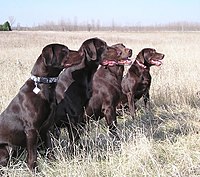 Image via Wikipedia
Image via Wikipedia
A Labrador retriever's feet are susceptible to various injuries if it spends much time outdoors. The pads of the feet should be inspected after every vigorous run in thick brush for cuts, splinters, burrs, or embedded stones. For minor problems, a cleaning, using sterilized tweezers to remove any objects, and a mild antiseptic should be all that is needed. The dog should not be permitted any hard running until the cut is healed. Undiscovered minor irritations can quickly become infected and painful, causing the dog to favor the leg and limp. A dog that develops a sudden limp may have been stung by an insect. In such a case, an ice compress will usually reduce or prevent swelling and the pain should quickly pass. (Be alert to any difficulty in breathing, as an allergic reaction to stings may also produce dangerous side effects.) If there is no evidence of a cut and the dog continues to favor the leg, consult a veterinarian as there may be an injury to the bones or muscles of the foot, or something may be embedded within the footpad that will need an experienced hand to remove.
Because many adult dogs dislike having their feet touched or inspected, begin this as a daily routine while the dog is young. Dogs that receive ample exercise outside the house will seldom need to have their nails trimmed, as moving about on rough surfaces should be enough to keep the nails quite short. Dogs that are more sedentary will need their nails attended to. If allowed to continue growing, the nails will impede the normal placement of the foot and affect the dog's gait.
Specially designed nail clippers for medium-sized dogs such as Labrador retrievers can be purchased at most pet shops or grooming parlors. The process is quick and painless, if done properly. If you are inexperienced with this, have your veterinarian show you this simple procedure at the dog's regular checkup. From then on this can be performed at home. Be sure to cut only the outer shell of the nail, as cutting too close to the quick will cause bleeding. Once the nail is the proper length, smooth the surface with a few touches of an emery board. Should bleeding occur from the cutting, apply pressure to the area by holding a cotton swab over the nail. Once the bleeding stops, dab the nail with a mild antiseptic.
In the wintertime, if you live in the colder areas, check your dog's feet after it walks on snow-covered or shoveled sidewalks. The chemicals that are commonly applied to melt snow on walkways and roads can be caustic to your dog's skin and feet and must be removed quickly by a thorough washing with warm, soapy water.
Follow this by applying a generous amount of petroleum jelly to the footpads to soothe any discomfort. If the use of such snow-melting chemicals is common in your area, ask your veterinarian to recommend a cream that you can apply to protect the footpads before damage occurs. If this salt is allowed to remain, the pads can be chemically burned. In response to the pain the dog may try to wash the chemicals off by licking, which complicates the problem further. If ingested in large enough doses, such materials can injure the digestive tract and other organs. The same applies to any antifreeze that may leak onto the streets. Not only is this liquid deadly, but it also actually attracts dogs by its pleasant smell and taste. Beware of letting your dog walk on or lick any liquids in the streets.
![Reblog this post [with Zemanta]](http://img.zemanta.com/reblog_e.png?x-id=1923e713-a49d-45f6-8847-628775bea5f0)
ไม่มีความคิดเห็น:
แสดงความคิดเห็น